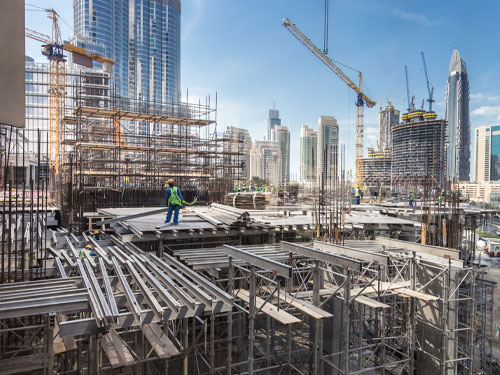
How to Find the Perfect Lot for a Single-Family Infill Development
In real estate development, single-family infill construction is one of the most rewarding yet challenging projects. It involves building a new home in an established neighborhood, making the best use of available land while enhancing the community’s character.
We’re Rockford Construction, and as a leading general contracting and construction company, we have successfully developed numerous infill homes and lots that help to transform a less desirable location into the backbone of a desirable neighborhood. And we’ve achieved this in areas throughout central Ohio.
In this blog article, we’ll share some insights on how to find the perfect lot for your next single-family infill development project.
Understanding Infill Development
Infill development is developing vacant or under-used parcels in urban areas, often within city limits and already-established neighborhoods. These are not always empty lots, as they sometimes contain abandoned buildings or other structures that may have fallen into disrepair.
Often infill lots are sandwiched between surrounding homes or businesses, creating possible physical constraints. But this type of development is essential for revitalizing neighborhoods, improving infrastructure efficiency, and promoting sustainable growth.


Why Infill Development?
Obviously, when it comes to infill development, you rarely start with a custom lot. Infill lots come in many configurations that can create construction and home design challenges. However, Infill development, particularly that of single-family homes, can offer developers, homeowners, and the community unique and beneficial opportunities.
Reusing land that was once abandoned or underutilized, these projects can transform blighted areas into thriving spaces, boosting property values and local economies while preserving historical areas or an existing neighborhood.
Moreover, infill development has several advantages over traditional suburban expansion. First and foremost among these is its reduced impact on the environment. Since infill projects use established infrastructure better, they often require fewer resources for new roads, utilities, or other amenities, saving money and preserving surrounding natural habitats.
Second, infill development encourages the efficient use of space by increasing population density in urban cores. This concentration of people can lead to improved public transit options and walkable communities with various services and amenities.
Lastly, through appropriate planning and architectural design, infill projects can foster social cohesion by providing diverse housing options and inspiring a sense of belonging to a traditional neighborhood among those living there.
Identify Your Objectives
Defining your objectives is critical before starting your search for the perfect infill lot. Are you looking to build a high-end home, an affordable housing option, or something in between? Who is your target market? What features are important to them?
Understanding these factors will help you identify suitable locations and evaluate potential infill lots. It’s essential to consider the type of neighborhood and surrounding community that would appeal to your target market.
Ensuring that the area meets a potential buyer’s or prospective resident’s requirements and aligns with their lifestyle preferences is crucial in making a well-informed decision.
Additionally, you need to take into account various factors like availability of utilities, zoning regulations, and accessibility when selecting an infill lot. Your project may have specific infrastructure requirements and need certain permissions depending on its scale and purpose.
Prioritize infill lots with easy access to key amenities and infrastructure that cater to your target demographic. By thoroughly researching the area and considering current trends and anticipated growth patterns, you’ll be better equipped to determine which infill lot best matches your objectives and has the potential for future success.
Carefully evaluating each factor before deciding will significantly increase the chances of finding a suitable infill lot for your project and achieving the desired results.


Choosing the Right Neighborhood
The location of your infill development is crucial to success. Selecting a neighborhood with strong demand for housing, where new developments are welcomed, will greatly contribute to your project’s appeal.
It is equally important to consider proximity to local amenities such as shopping centers, educational institutions like schools, recreational facilities like parks, and other essential establishments.
Taking into account the availability of public transportation options and the ease of access to major roads plays a significant role in attracting potential buyers who prioritize convenience and seamless connectivity.
Another element that should be considered is conducting thorough research on local real estate trends and any plans for the area where you intend to develop your project. Understanding the market conditions and identifying neighborhoods on the rise will ensure that your infill development remains competitive and attractive to potential buyers.
Aligning your project’s vision with the broader aspirations of the community can assist in positioning it as a valuable addition to an already established area and position you in a positive light with your potential neighbors.
Indeed, being mindful of these factors while selecting a location for your infill development will provide you with a strong foundation for achieving long-term success and meeting the community’s housing needs.
Evaluating the Lot
Once you’ve identified a potential infill lot, you must evaluate it thoroughly. Here are some factors to consider:
Size and Shape
Is the lot large enough for your planned home while also meeting local zoning and setback requirements? Is the shape of the lot conducive to your design?
Topography
Flat lots are generally easier and cheaper to build on than sloping ones. However, a sloping lot can offer interesting design possibilities, like a walk-out basement or multi-level home.
Utilities
Check if the lot can access essential utilities like water, sewer, electricity, and gas. If not, consider the cost of bringing these services to the site.
Environmental Factors
Consider factors like soil condition, drainage, and the presence of mature trees or protected species. You may need to conduct a site assessment to uncover any potential environmental issues.


Working with Local Authorities
Navigating zoning regulations and obtaining necessary permits can be challenging. Understanding local building codes, zoning laws, and any architectural guidelines specific to the neighborhood is essential.
This can be especially tricky when building in an old neighborhood with many unique characteristics, including old structures of historical importance, cultural landmarks, or architectural styles.
The team at Rockford Construction recommends working closely with local authorities to ensure your project complies with all requirements. This will save you time and money in the long run.
One of the first steps in navigating this complex process is identifying the specific zoning regulations relevant to your property and project. Different property types may have different regulations, such as residential versus commercial or industrial areas.
Familiarizing yourself with these rules will allow you to plan your project accordingly and minimize potential obstacles or delays. Furthermore, it is crucial to understand any overlays or designations that may affect your project, as these could add extra layers of regulation and may dictate the materials, styles, or other aspects of construction.
Working collaboratively with local authorities can be invaluable in these situations—schedule face-to-face meetings to discuss your plans and seek guidance on essential documentation required for proper compliance.
Public officials with expertise in building codes will ensure that you adhere to safety standards and may suggest alternatives for any non-compliant aspects of your project you might run into.
Keep communication lines open throughout the process and keep officials updated on project progress since establishing a cooperative relationship will prove beneficial in resolving any potential issues that could arise.
Budgeting for Your Project
The total cost of your project should also play a significant role in your decision-making process. This includes the purchase price of the lot, construction costs, permit fees, utility hookups, landscaping, and any unexpected expenses that may arise during development.
Be prepared for fluctuations in material prices, labor availability, and potential governmental regulations that could impact your budget and timeline. When doing due diligence on a prospective lot for your project, performing a thorough cost analysis is essential to avoid financial setbacks.
Remember that the most expensive lot isn’t necessarily the best one for your specific needs; it’s about finding a balance between the cost of the lot and its potential return on investment.
Sometimes, a less expensive property in an up-and-coming area may yield higher returns than more costly options. In other situations, investing in premium real estate with more immediate access to resources, infrastructure, and amenities could fit better into your overall plan.
Ultimately, striking this balance relies primarily on informed decision-making supported by your own research into each unique opportunity before making a final commitment.


Is Infill For You?
Finding the perfect lot for a single-family infill development requires careful research, thorough site evaluation, and a clear understanding of your project objectives. By doing your homework, you can find a lot that meets your needs, fits your budget, and gives you the best chance of success on your infill development project.
Partner with Us
With our expertise in various types of residential construction, including single-family infill, Rockford Construction is here to assist you every step of the way. From site selection to the final build, we’re committed to delivering quality results that exceed your expectations. Contact us today to learn more about how we can make your next infill development project successful.


